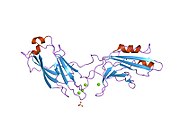SYT3
Protein-coding gene in the species Homo sapiens
| SYT3 | |||||||||||||||||||||||||||||||||||||||||||||||||||
|---|---|---|---|---|---|---|---|---|---|---|---|---|---|---|---|---|---|---|---|---|---|---|---|---|---|---|---|---|---|---|---|---|---|---|---|---|---|---|---|---|---|---|---|---|---|---|---|---|---|---|---|
 | |||||||||||||||||||||||||||||||||||||||||||||||||||
| Identifiers | |||||||||||||||||||||||||||||||||||||||||||||||||||
| Aliases | SYT3, SytIII, synaptotagmin 3 | ||||||||||||||||||||||||||||||||||||||||||||||||||
| External IDs | OMIM: 600327 MGI: 99665 HomoloGene: 9617 GeneCards: SYT3 | ||||||||||||||||||||||||||||||||||||||||||||||||||
| |||||||||||||||||||||||||||||||||||||||||||||||||||
| |||||||||||||||||||||||||||||||||||||||||||||||||||
| |||||||||||||||||||||||||||||||||||||||||||||||||||
| |||||||||||||||||||||||||||||||||||||||||||||||||||
| |||||||||||||||||||||||||||||||||||||||||||||||||||
| Wikidata | |||||||||||||||||||||||||||||||||||||||||||||||||||
| |||||||||||||||||||||||||||||||||||||||||||||||||||
Synaptotagmin-3 is a protein that in humans is encoded by the SYT3 gene.[5][6]
References
- ^ a b c GRCh38: Ensembl release 89: ENSG00000213023 – Ensembl, May 2017
- ^ a b c GRCm38: Ensembl release 89: ENSMUSG00000030731 – Ensembl, May 2017
- ^ "Human PubMed Reference:". National Center for Biotechnology Information, U.S. National Library of Medicine.
- ^ "Mouse PubMed Reference:". National Center for Biotechnology Information, U.S. National Library of Medicine.
- ^ Jones JM, Popma SJ, Mizuta M, Seino S, Meisler MH (March 1995). "Synaptotagmin genes on mouse chromosomes 1, 7, and 10 and human chromosome 19" (PDF). Mammalian Genome. 6 (3): 212–3. doi:10.1007/BF00293017. hdl:2027.42/47020. PMID 7749232. S2CID 24653745.
- ^ "Entrez Gene: SYT3 synaptotagmin III".
Further reading
- Li C, Ullrich B, Zhang JZ, Anderson RG, Brose N, Südhof TC (June 1995). "Ca(2+)-dependent and -independent activities of neural and non-neural synaptotagmins". Nature. 375 (6532): 594–9. Bibcode:1995Natur.375..594L. doi:10.1038/375594a0. PMID 7791877. S2CID 4265549.
- Fukuda M, Kanno E, Mikoshiba K (October 1999). "Conserved N-terminal cysteine motif is essential for homo- and heterodimer formation of synaptotagmins III, V, VI, and X". The Journal of Biological Chemistry. 274 (44): 31421–7. doi:10.1074/jbc.274.44.31421. PMID 10531343.
- Gerona RR, Larsen EC, Kowalchyk JA, Martin TF (March 2000). "The C terminus of SNAP25 is essential for Ca(2+)-dependent binding of synaptotagmin to SNARE complexes". The Journal of Biological Chemistry. 275 (9): 6328–36. doi:10.1074/jbc.275.9.6328. PMID 10692432.
- Mizutani A, Fukuda M, Ibata K, Shiraishi Y, Mikoshiba K (March 2000). "SYNCRIP, a cytoplasmic counterpart of heterogeneous nuclear ribonucleoprotein R, interacts with ubiquitous synaptotagmin isoforms". The Journal of Biological Chemistry. 275 (13): 9823–31. doi:10.1074/jbc.275.13.9823. PMID 10734137.
- Hartley JL, Temple GF, Brasch MA (November 2000). "DNA cloning using in vitro site-specific recombination". Genome Research. 10 (11): 1788–95. doi:10.1101/gr.143000. PMC 310948. PMID 11076863.
- Wiemann S, Weil B, Wellenreuther R, Gassenhuber J, Glassl S, Ansorge W, Böcher M, Blöcker H, Bauersachs S, Blum H, Lauber J, Düsterhöft A, Beyer A, Köhrer K, Strack N, Mewes HW, Ottenwälder B, Obermaier B, Tampe J, Heubner D, Wambutt R, Korn B, Klein M, Poustka A (March 2001). "Toward a catalog of human genes and proteins: sequencing and analysis of 500 novel complete protein coding human cDNAs". Genome Research. 11 (3): 422–35. doi:10.1101/gr.GR1547R. PMC 311072. PMID 11230166.
- Simpson JC, Wellenreuther R, Poustka A, Pepperkok R, Wiemann S (September 2000). "Systematic subcellular localization of novel proteins identified by large-scale cDNA sequencing". EMBO Reports. 1 (3): 287–92. doi:10.1093/embo-reports/kvd058. PMC 1083732. PMID 11256614.
- Craxton M (September 2001). "Genomic analysis of synaptotagmin genes". Genomics. 77 (1–2): 43–9. doi:10.1006/geno.2001.6619. PMID 11543631.
- Wiemann S, Arlt D, Huber W, Wellenreuther R, Schleeger S, Mehrle A, Bechtel S, Sauermann M, Korf U, Pepperkok R, Sültmann H, Poustka A (October 2004). "From ORFeome to biology: a functional genomics pipeline". Genome Research. 14 (10B): 2136–44. doi:10.1101/gr.2576704. PMC 528930. PMID 15489336.
- Rual JF, Venkatesan K, Hao T, Hirozane-Kishikawa T, Dricot A, Li N, Berriz GF, Gibbons FD, Dreze M, Ayivi-Guedehoussou N, Klitgord N, Simon C, Boxem M, Milstein S, Rosenberg J, Goldberg DS, Zhang LV, Wong SL, Franklin G, Li S, Albala JS, Lim J, Fraughton C, Llamosas E, Cevik S, Bex C, Lamesch P, Sikorski RS, Vandenhaute J, Zoghbi HY, Smolyar A, Bosak S, Sequerra R, Doucette-Stamm L, Cusick ME, Hill DE, Roth FP, Vidal M (October 2005). "Towards a proteome-scale map of the human protein-protein interaction network". Nature. 437 (7062): 1173–8. Bibcode:2005Natur.437.1173R. doi:10.1038/nature04209. PMID 16189514. S2CID 4427026.
- Mehrle A, Rosenfelder H, Schupp I, del Val C, Arlt D, Hahne F, Bechtel S, Simpson J, Hofmann O, Hide W, Glatting KH, Huber W, Pepperkok R, Poustka A, Wiemann S (January 2006). "The LIFEdb database in 2006". Nucleic Acids Research. 34 (Database issue): D415-8. doi:10.1093/nar/gkj139. PMC 1347501. PMID 16381901.
- v
- t
- e
PDB gallery
-
 1dqv: CRYSTAL STRUCTURE OF SYNAPTOTAGMIN III C2A/C2B
1dqv: CRYSTAL STRUCTURE OF SYNAPTOTAGMIN III C2A/C2B
 | This protein-related article is a stub. You can help Wikipedia by expanding it. |
- v
- t
- e



















